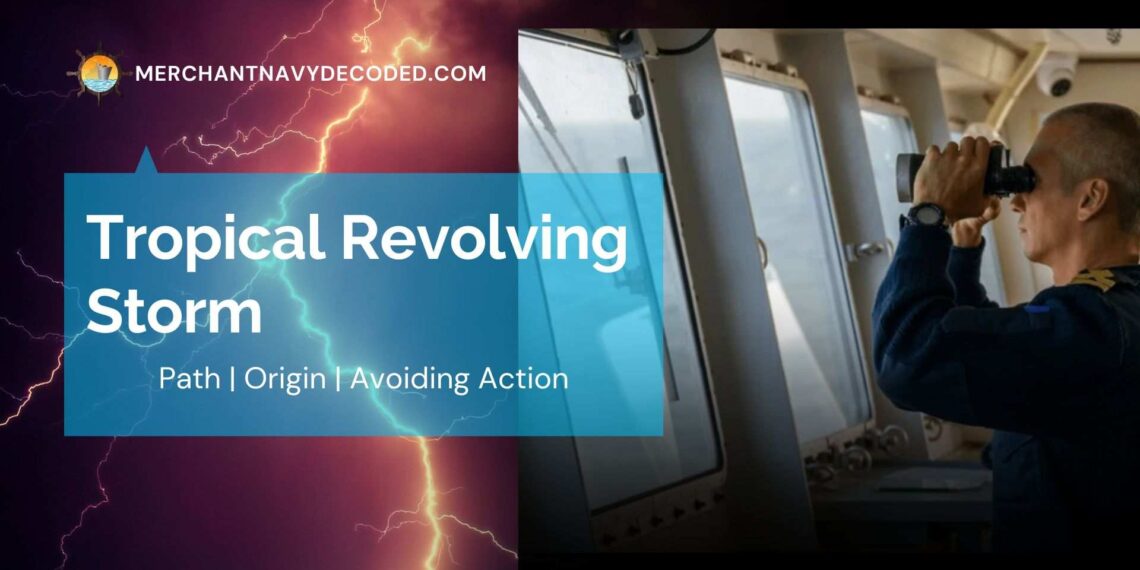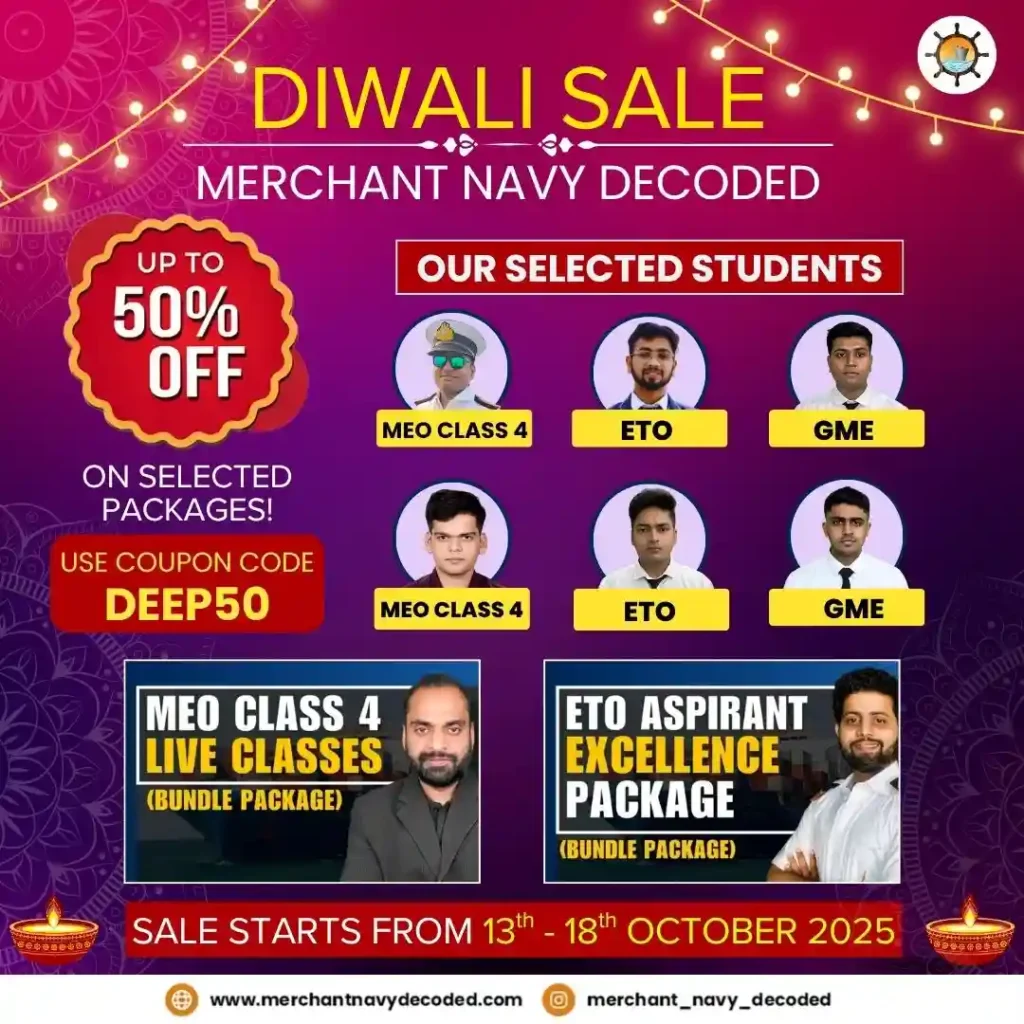What is Tropical Revolving Storms | Actions Taken by Ship in TRS
1:- Tropical Revolving Storms(TRS) Overview
- A Tropical Revolving Storm used to be a Mariner’s Nightmare. With advancements in weather forecasting and weather routing services, they have become more manageable for the vessel and its managers.
- Depending on your location, you may call it whatever it is called locally, but all of them will have one thing in common – Destruction.
- In this blog, we will be talking about TRS in detail from a merchant navy perspective and try to provide as many details as possible to help you understand about Tropical Revolving Storm.
2:- What is a Tropical Revolving Storm?
- A TRS may be defined as a circular atmospheric vortex, originating in the tropics or subtropics, with winds blowing in converging spiral tracks that reach or exceed gale force (Beaufort Force 8).
- Winds in a TRS blow anti-clockwise in the Northern Hemisphere and clockwise in the Southern Hemisphere.
| Wind speed (in Knots) | Wind force | Wind force |
| 33 or less | 7 or less | Depression |
| 34 to 47 | 8 and 9 | Moderate Cyclone |
| 48 to 63 | 10 and 11 | Severe Cyclone |
| 64 to 119 | 12 and over | Very Severe Cyclone |
| 120 and over | Over 12 | Super Cyclone |
3:- Formation of a Cyclone

- Tropical Revolving Storm originates in latitudes between 5 and 20 degrees
- It travels between W and WNW in the Northern Hemisphere and between W and WSW in the Southern Hemisphere, at a speed of about 12- 15 Knots.
- Somewhere along the track, they curve away from the equator – to the N and then recurve to the NE in the Northern Hemisphere and the S and then to SE in the Southern Hemisphere.
- After recurving the storm travels around the Oceanic High (situated at about 30 degrees North and 30 degrees South in the middle of large oceans). Speed of travel increases to about 15 – 20 Knots.
- Sometimes a TRS does not recurve at all, continues on the original path, crosses the coast, and dissipates quickly due to friction and lack of moisture.
- The average lifespan of a tropical cyclone is about 6-7 days. In reality, the cyclone can last anywhere between 1-19 days.
4:- Conditions for the Formation of a TRS
The following are the ideal conditions that aid the formation of a Cyclone:
- High relative humidity
- High temperature
- The low-pressure area is surrounded by areas of High Pressure
- Convection current flowing
- A fair amount of Coriolis Force (Latitude more than 5 degrees north or South)
- Weak prevailing winds
5:- Structure of a Tropical Revolving Storm

These storms have some features common with depressions of higher latitudes. A Fully Developed cyclone usually has three distinct parts:
- The Eye or Vortex:
- It is the calm central area having the lowest pressure. It has a diameter between 4 and 30 Nautical Miles.
- The Eye Wall:
- Inner Ring of Hurricane Force winds.
- Width is between 4-30 Nautical miles.
- The pressure gradient in the eye wall is very steep, registering a near-vertical trend.
- Winds blow in a perfectly circular path and can reach speeds up to 130 Kts, with occasional gusts of 150 Kts.
- Outer Storm Area:
- This is the area surrounding the eye wall.4
- It has a diameter between 50-800 Nautical miles. The average diameter is about 500 Nautical Mile.
- Winds reach Force 6-7.
- The pressure gradient is much less than the eye wall.
6:- Important Parts of a TRS
- Track: The route the storm’s center has previously traversed.
- Path: The projected route the storm’s center is anticipated to take.
- Trough: A line through the storm’s center, perpendicular to the track, where pressure decreases ahead of it and increases behind it.
- Vertex or Cod: The farthest west longitude reached by the storm center during its recurving.
- Right-hand semicircle (RHSC): The portion of the storm center to the right of an observer facing the storm’s direction of movement.
- Left-hand semicircle (LHSC): The portion of the storm center to the left of an observer facing the storm’s direction of movement.
- Dangerous semicircle: The RHSC in the Northern Hemisphere and the LHSC in the Southern Hemisphere.
- Navigable semicircle: The LHSC in the Northern Hemisphere and the RHSC in the Southern Hemisphere.
- Dangerous quadrant: The leading quadrant of the RHSC in the Northern Hemisphere and the LHSC in the Southern Hemisphere.
7:- Warning Signs of a TRS

Advanced Weather forecasting techniques have drastically improved forecasting capabilities but it is always a good seamanship practice to know some typical signs of an approaching Tropical Cyclones.
If you see the following signs when out at sea, you should be alerted of the possibility of a storm:
- Swell: A strong swell is usually the first indication of an approaching TRS. Swell is different from current and is created by the strong winds of a storm far away that sends it in various directions.
- A steady fall in atmospheric pressure. The presence of a TRS is confirmed if the barometric fall in pressure is more than 5 mb below normal. A pressure drop of 20 mb is enough to create a well-developed tropical revolving storm (TRS).
- An appreciable change in the direction and strength of the wind should be viewed suspiciously.
- An unusually clear sky and calm weather may be a viable indication.
- Historically speaking, mariners have feared a dark red/copper color of the sky before a tropical revolving storm.
- Weather reports based on satellite pictures and observations from other vessels may have storm warnings, although typically restricted to only a few per day.
8:- Actions for Ships in Area of a TRS
The fundamental idea of navigating an area in the vicinity of a cyclone is to be as far away from the storm as possible or be in close sheltered waters if possible. Shore-based routing services help masters in route planning and make more informed decisions in such critical situations. However, the following points shall be adhered to:
- Obtain Bearing of the Storm Centre:
- Accurate Positioning of the storm center is done using Meteorological Warnings from shore-based stations.
- To have a rough estimate, Buys Ballot’s Law may be used; ‘Face the wind, and according to Buys Ballot’s law, the storm center will lie 8 to 12 points on your right in the Northern Hemisphere, and in the left in Southern Hemisphere‘.
- Check-in which semi-circle the vessel lies.
- For a stationary observer, if the wind veers, the vessel is in the RHSC(Right Hand Semicircle), and if it backs, LHSC(Left Hand Semicircle). This holds good for both the Northern and Southern Hemisphere.
9:- TRS Avoiding Action
- If the vessel is in the dangerous quadrant:
- Proceed as quickly as possible with the wind positioned 1 to 4 points on the starboard bow (or port bow in the Southern Hemisphere) – 1 point for vessels moving slower than 12 knots and 4 points for those moving faster than 12 knots – while adjusting course as the wind changes direction (backs in the Southern Hemisphere). Maintain this course until the pressure normalizes, indicating the vessel is outside the storm’s outer area.
- If there is limited space, the vessel should heave with the wind on the starboard bow (or port bow in the Southern Hemisphere) and remain in this position until the storm has passed.
- If the vessel is in the path of the storm or if in the navigable semi-circle:
- Proceed as quickly as possible with the wind approximately 4 points on the starboard quarter (port quarter in the Southern Hemisphere), adjusting course as the wind changes direction (veers in the Southern Hemisphere).
- If the vessel is in port:
- The vessel may be advised to proceed well out at sea to have enough room and under-keel clearance. If the vessel cannot proceed to sea, the vessel may be advised to anchor outside the port in any shelter she can find. The engines should be ready for maneuver.
10:- Conclusion:
The ever-unpredictable nature of the sea makes it a challenging realm to accomplish. However, men have conquered the sea for ages using wooden ships and sails. Advanced technology and better ships have made it easier to sail across ruthless oceans. Hence, a strong heart, sound mind, and proper knowledge are essential for keeping lives and ships safe out at sea and amidst such dangerous cyclones. The Merchant Navy thus inspires us to be fearless and face forces mightier than absolutely head-on, with no chance of an escape.
Disclaimer :- The opinions expressed in this article belong solely to the author and may not necessarily reflect those of Merchant Navy Decoded. We cannot guarantee the accuracy of the information provided and disclaim any responsibility for it. Data and visuals used are sourced from publicly available information and may not be authenticated by any regulatory body. Reviews and comments appearing on our blogs represent the opinions of individuals and do not necessarily reflect the views of Merchant Navy Decoded. We are not responsible for any loss or damage resulting from reliance on these reviews or comments.
Reproduction, copying, sharing, or use of the article or images in any form is strictly prohibited without prior permission from both the author and Merchant Navy Decoded.




